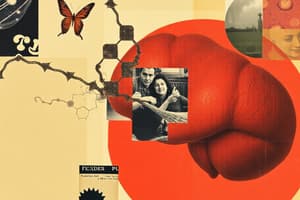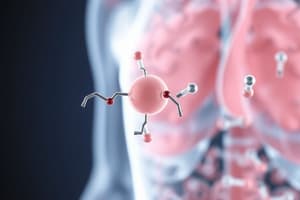Podcast
Questions and Answers
What is a preprohormone primarily composed of?
What is a preprohormone primarily composed of?
- Amine hormone derivatives
- Single amino acid modifications
- Active hormone and signal sequence
- Large inactive protein with peptide hormone copies (correct)
How is the activity of peptide hormones primarily terminated in the body?
How is the activity of peptide hormones primarily terminated in the body?
- Through competitive binding to other receptors
- By the formation of intracellular signaling complexes
- By degradation through plasma enzymes (correct)
- By modification in the liver
Which hormone classification is derived from cholesterol?
Which hormone classification is derived from cholesterol?
- Protein fragments
- Steroid hormones (correct)
- Amine hormones
- Peptide hormones
What occurs during post-translational modification of peptide hormones?
What occurs during post-translational modification of peptide hormones?
What initiates the release of peptide hormone-containing secretory vesicles?
What initiates the release of peptide hormone-containing secretory vesicles?
What type of hormones are considered to be modifications of single amino acids?
What type of hormones are considered to be modifications of single amino acids?
Which of the following components is NOT part of the endoplasmic reticulum's process for peptide hormones?
Which of the following components is NOT part of the endoplasmic reticulum's process for peptide hormones?
What term describes the process of releasing all peptide fragments from prohormones into the extracellular fluid?
What term describes the process of releasing all peptide fragments from prohormones into the extracellular fluid?
Which cell type in the islets of Langerhans is primarily responsible for insulin production?
Which cell type in the islets of Langerhans is primarily responsible for insulin production?
What role does glucagon play in the body?
What role does glucagon play in the body?
In a fed state, which of the following occurs due to the dominance of insulin?
In a fed state, which of the following occurs due to the dominance of insulin?
What is the primary function of D cells in the islets of Langerhans?
What is the primary function of D cells in the islets of Langerhans?
What happens to insulin and glucagon levels shortly after a meal?
What happens to insulin and glucagon levels shortly after a meal?
How does the body manage plasma glucose levels during fasting?
How does the body manage plasma glucose levels during fasting?
Which hormone is primarily responsible for the conversion of excess glucose into fat?
Which hormone is primarily responsible for the conversion of excess glucose into fat?
What is the typical fasting plasma glucose level maintained in a normal person?
What is the typical fasting plasma glucose level maintained in a normal person?
Which structure is responsible for the secretion of neurohormones in the brain?
Which structure is responsible for the secretion of neurohormones in the brain?
What are the two neurohormones stored and released by the posterior pituitary?
What are the two neurohormones stored and released by the posterior pituitary?
What initiates the release of neurohormones from the posterior pituitary?
What initiates the release of neurohormones from the posterior pituitary?
How do neurohormones travel after being released into the blood?
How do neurohormones travel after being released into the blood?
What is the primary function of vasopressin in the body?
What is the primary function of vasopressin in the body?
What is the primary purpose of binding steroid hormones to protein carriers?
What is the primary purpose of binding steroid hormones to protein carriers?
In what part of the pituitary is oxytocin synthesized?
In what part of the pituitary is oxytocin synthesized?
Where are steroid hormone receptors primarily located within the target cells?
Where are steroid hormone receptors primarily located within the target cells?
What are the amino acid compositions of oxytocin and vasopressin?
What are the amino acid compositions of oxytocin and vasopressin?
What effect do steroid hormones have once they bind to their receptors in the nucleus?
What effect do steroid hormones have once they bind to their receptors in the nucleus?
What is the primary role of oxytocin during labor and breastfeeding?
What is the primary role of oxytocin during labor and breastfeeding?
Which statement accurately describes the lag time associated with steroid hormones?
Which statement accurately describes the lag time associated with steroid hormones?
Which substances are the amino acid-derived hormones primarily created from?
Which substances are the amino acid-derived hormones primarily created from?
What is the role of the output signal in endocrine reflex pathways?
What is the role of the output signal in endocrine reflex pathways?
Which hormone is derived from tryptophan?
Which hormone is derived from tryptophan?
What factor impacts the constant ratio of unbound to bound steroid hormones in the plasma?
What factor impacts the constant ratio of unbound to bound steroid hormones in the plasma?
What is the primary effect of PTH on phosphate reabsorption in the kidneys?
What is the primary effect of PTH on phosphate reabsorption in the kidneys?
Which hormone primarily facilitates the intestinal absorption of calcium?
Which hormone primarily facilitates the intestinal absorption of calcium?
What triggers the secretion of calcitonin?
What triggers the secretion of calcitonin?
How does PTH indirectly contribute to calcium absorption in the intestines?
How does PTH indirectly contribute to calcium absorption in the intestines?
Which of the following is NOT a function of calcitriol?
Which of the following is NOT a function of calcitriol?
Which demographic group may need vitamin D supplementation due to insufficient sunlight exposure?
Which demographic group may need vitamin D supplementation due to insufficient sunlight exposure?
What happens when the plasma calcium concentration increases?
What happens when the plasma calcium concentration increases?
What is the role of prolactin in calcium balance during lactation?
What is the role of prolactin in calcium balance during lactation?
What is the primary necessity for obtaining essential amino acids?
What is the primary necessity for obtaining essential amino acids?
What effect does cortisol have on growth in children?
What effect does cortisol have on growth in children?
At what point in life does peak secretion of growth hormone typically occur?
At what point in life does peak secretion of growth hormone typically occur?
What is the role of growth hormone-releasing hormone (GHRH)?
What is the role of growth hormone-releasing hormone (GHRH)?
How does growth hormone affect secretion of insulin-like growth factors?
How does growth hormone affect secretion of insulin-like growth factors?
Which organ is primarily responsible for the secretion of growth hormone?
Which organ is primarily responsible for the secretion of growth hormone?
What function does the growth hormone-binding protein serve in the bloodstream?
What function does the growth hormone-binding protein serve in the bloodstream?
Which of the following factors is NOT a stimulus for growth hormone release?
Which of the following factors is NOT a stimulus for growth hormone release?
Flashcards
Hormone Half Life
Hormone Half Life
The time it takes for the concentration of a hormone in the body to reduce by half.
Plasma Enzymes
Plasma Enzymes
Enzymes in the blood that break down peptide hormones by breaking their peptide bonds.
Endocytosis
Endocytosis
The process where a cell engulfs a hormone and receptor complex, bringing it inside the cell for degradation.
Intracellular Hormone Metabolism
Intracellular Hormone Metabolism
Signup and view all the flashcards
Peptide/Protein Hormones
Peptide/Protein Hormones
Signup and view all the flashcards
Steroid Hormones
Steroid Hormones
Signup and view all the flashcards
Amino Acid-Derived Hormones
Amino Acid-Derived Hormones
Signup and view all the flashcards
Preprohormone
Preprohormone
Signup and view all the flashcards
What is the pituitary gland?
What is the pituitary gland?
Signup and view all the flashcards
What is the anterior pituitary?
What is the anterior pituitary?
Signup and view all the flashcards
What does the posterior pituitary do?
What does the posterior pituitary do?
Signup and view all the flashcards
What does oxytocin do?
What does oxytocin do?
Signup and view all the flashcards
What does vasopressin do?
What does vasopressin do?
Signup and view all the flashcards
Where are neurohormones made?
Where are neurohormones made?
Signup and view all the flashcards
How are neurohormones released?
How are neurohormones released?
Signup and view all the flashcards
How do neurohormones reach their targets?
How do neurohormones reach their targets?
Signup and view all the flashcards
What is the characteristic of steroid hormones that allows them to enter cells?
What is the characteristic of steroid hormones that allows them to enter cells?
Signup and view all the flashcards
How do carrier proteins affect steroid hormone delivery?
How do carrier proteins affect steroid hormone delivery?
Signup and view all the flashcards
Where are steroid hormone receptors located and what is their function?
Where are steroid hormone receptors located and what is their function?
Signup and view all the flashcards
What is the role of the steroid hormone-receptor complex?
What is the role of the steroid hormone-receptor complex?
Signup and view all the flashcards
What is the term for the effect of steroid hormones on gene expression?
What is the term for the effect of steroid hormones on gene expression?
Signup and view all the flashcards
Why is there a lag time between steroid hormone binding and the observed biological effect?
Why is there a lag time between steroid hormone binding and the observed biological effect?
Signup and view all the flashcards
Which amino acids are the precursors for amino acid-derived hormones?
Which amino acids are the precursors for amino acid-derived hormones?
Signup and view all the flashcards
What is the key structural feature of the amino acids used to create amino acid-derived hormones?
What is the key structural feature of the amino acids used to create amino acid-derived hormones?
Signup and view all the flashcards
Dietary Requirements for Growth
Dietary Requirements for Growth
Signup and view all the flashcards
Essential Amino Acids
Essential Amino Acids
Signup and view all the flashcards
Calcium for Bone Growth
Calcium for Bone Growth
Signup and view all the flashcards
Stress and Growth
Stress and Growth
Signup and view all the flashcards
Genetic Determination of Height
Genetic Determination of Height
Signup and view all the flashcards
Growth Hormone's Role in Growth
Growth Hormone's Role in Growth
Signup and view all the flashcards
GHRH and SS - GH Regulators
GHRH and SS - GH Regulators
Signup and view all the flashcards
GH's Target Tissues and IGFs
GH's Target Tissues and IGFs
Signup and view all the flashcards
What are the endocrine functions of the pancreas?
What are the endocrine functions of the pancreas?
Signup and view all the flashcards
What do beta cells produce, and what are their roles?
What do beta cells produce, and what are their roles?
Signup and view all the flashcards
What do alpha cells produce, and what is its role?
What do alpha cells produce, and what is its role?
Signup and view all the flashcards
How does the insulin-to-glucagon ratio regulate metabolism?
How does the insulin-to-glucagon ratio regulate metabolism?
Signup and view all the flashcards
What happens when insulin predominates in the body?
What happens when insulin predominates in the body?
Signup and view all the flashcards
What happens when glucagon predominates in the body?
What happens when glucagon predominates in the body?
Signup and view all the flashcards
How does the liver produce glucose during glucagon dominance?
How does the liver produce glucose during glucagon dominance?
Signup and view all the flashcards
How does the body respond to a rise in blood glucose after a meal?
How does the body respond to a rise in blood glucose after a meal?
Signup and view all the flashcards
How does PTH affect calcium reabsorption?
How does PTH affect calcium reabsorption?
Signup and view all the flashcards
How does PTH affect phosphate reabsorption?
How does PTH affect phosphate reabsorption?
Signup and view all the flashcards
How does PTH affect intestinal calcium absorption?
How does PTH affect intestinal calcium absorption?
Signup and view all the flashcards
What is the role of calcitriol in calcium homeostasis?
What is the role of calcitriol in calcium homeostasis?
Signup and view all the flashcards
What other functions does calcitriol have besides intestinal calcium absorption?
What other functions does calcitriol have besides intestinal calcium absorption?
Signup and view all the flashcards
What is the function of calcitonin in calcium homeostasis?
What is the function of calcitonin in calcium homeostasis?
Signup and view all the flashcards
When is calcitonin released?
When is calcitonin released?
Signup and view all the flashcards
What is the overall importance of calcium homeostasis?
What is the overall importance of calcium homeostasis?
Signup and view all the flashcards
Study Notes
Endocrine System Overview
- Endocrinology is the study of hormones
- Hormones are chemical messengers secreted into the bloodstream by specialized cells
- Hormones control long-term, ongoing body functions, including growth, development, metabolism, internal environment regulation, and reproduction
- Hormones act on target cells in three ways: controlling enzymatic reactions, controlling ion or molecule transport across cell membranes, or controlling gene expression and protein synthesis
- A hormone is a chemical secreted by a cell or group of cells into the blood to transport it to a distant target, where it exerts its effect at very low concentrations
What Makes a Chemical a Hormone?
- Hormones are secreted by cells, not just classic endocrine glands
- Endocrine cells, neurons (neurohormones), and immune cells (cytokines) can secrete hormones
- Hormones are secreted into the bloodstream; however, the term ectohormone is given to signal molecules secreted into the external environment (ex. pheromones)
- Some chemical signals in the blood may not be considered hormones because they need to be present in high concentrations to have an effect
- Hormones act on target cells at very low concentrations (nanomolar to picomolar)
Hormone Action and Termination
- Hormones bind to target cell receptors to initiate biochemical responses
- Hormone effects can vary depending on the tissue and developmental stage, or a hormone may have no effect in a certain cell
- Hormones must be terminated for the body to respond appropriately to changes in the body
- Hormones are terminated by limiting secretion, removing/inactivating circulating hormones in the blood, or terminating hormone activity in target cells
- Hormones are degraded into inactive metabolites by enzymes located primarily in the liver and kidneys
- Hormones' half-lives indicate how long the hormone is active in the body
Classification of Hormones
- Hormones are classified into three main types: peptide/protein hormones, steroid hormones, and amino acid-derived (amine) hormones
- Peptide/protein hormones are chains of amino acids
- Steroid hormones are derived from cholesterol
- Amine hormones are modifications of tyrosine or tryptophan
Peptide/Protein Hormones
- Synthesis, storage, and release of peptide hormones into membrane-bound secretory vesicles is similar to other proteins
- The initial peptide is a large inactive protein called a preprohormone
- Preprohormones undergo post-translational modification in the Golgi apparatus to become active hormones and other fragments
Steroid Hormones
- Steroid hormones are derived from cholesterol and have a similar chemical structure
- Hormone production for steroid hormones is located in specific organs, unlike peptide hormones
- Steroid hormones are not very soluble in plasma and other body fluids
- Most steroid hormones bind to carrier proteins in the blood, extending their half-lives
Cellular Mechanism of Action of Steroid Hormones
- Steroid hormone receptors are found within the cell, in either the cytoplasm or nucleus
- Steroid receptors bind to hormones and act as transcription factors in the nucleus
- Steroid hormone effects generally take a longer time because they affect gene activity
- Steroid hormones do not mediate rapid reflex pathways
Additional Hormone Interactions
- Three main types of hormone interactions: synergism, permissiveness, antagonism
- Synergism: combined effect of multiple hormones exceeding the additive sum of individual effects
- Permissiveness: one hormone enabling another hormone's full effect
- Antagonism: two hormones having opposite effects
Homeostatic Control of Metabolism and the Role of Hormones
- The ratio of insulin and glucagon influences an individual's hour-to-hour metabolic state
- Insulin dominates during the fed state, promoting anabolism by storing glucose as glycogen or fat
- Glucagon dominates during the fasted state, promoting catabolism of glycogen and other storage sources of glucose
- Glucagon has more significant metabolic effects when blood glucose levels are low
Endocrine Response to Hypoglycemia/Plasma Glucose Hormones
- Glucagon, released when glucose is low, promotes glycogenolysis and gluconeogenesis to replenish plasma glucose
- The ratio of insulin to glucagon dictates the direction of metabolism; both play roles in maintaining blood glucose levels
Adrenal Glucocorticoids
- Adrenal glands sit atop kidneys, comprised of cortex and medulla
- Medulla secretes catecholamines (mostly norepinephrine) in response to stress
- Cortex secretes steroid hormones including aldosterone (mineralocorticoid), glucocorticoids, and sex hormones
- Cortisol is the major glucocorticoid, impacting glucose metabolism, immunology, and stress response; a prime example of a stress hormone
Thyroid Hormones
- Located in the neck, thyroid gland contains follicular and C cells
- Follicular cells secrete thyroid hormones, essential for growth and development (especially in children)
- Thyroid hormones are made from tyrosine and iodine
- Thyroid stimulating hormone (TSH) from the anterior pituitary, regulates thyroid hormone synthesis and secretion
Growth Hormone
- Growth in humans is continuous but not consistently so across different periods in life (ex. adolescence)
- Growth hormone (GH) promotes protein synthesis and bone and tissue growth
- Several factors influence growth hormone, including: hormones other than GH, diet, genetics, and lack of stress
Calcium Balance
- Most calcium is stored in bones, however, nonbone calcium, found in extracellular and intracellular fluids, is crucial to physiological functioning
- Several hormones regulate calcium levels within the body.
Hormones and Their Action Pathways
- Specific hormones have their own distinct pathways for signaling and eliciting a response; all hormones bind to specific receptors
- Hormones can affect many tissues and organs at once through complex interactions
- Different types of hormones signal through different pathways
Studying That Suits You
Use AI to generate personalized quizzes and flashcards to suit your learning preferences.





